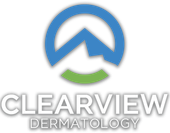Mohs Micrographic Surgery
At Clearview Dermatology, our skin cancer team is led by a double Board-Certified Dermatologist and Mohs Surgeon who is fellowship-trained in Mohs skin cancer surgery. After completing 4 years of residency training in dermatology, Dr. Overman completed a one-year intensive fellowship in Mohs Micrographic and Reconstructive Surgery at Oregon Health Science University in Portland, Oregon, one of the top hospitals for Mohs surgery training in the United States. Dr. Overman has performed over 8,000 Mohs surgeries to date. Our staff is dedicated to the highest level of procedural dermatology care including advanced skin cancer management, Mohs surgery, reconstructive surgery, and laser & cosmetic dermatology. Dr. Overman’s fellowship included advanced training in Mohs micrographic surgery, reconstructive and facial plastic surgery, and advanced cosmetic procedures like cosmetic lasers and cosmetic scar revision.
Mohs Micrographic Surgery is the most advanced and effective treatment procedure for
skin cancer available today. The procedure is performed by specially trained surgeons who have completed at least one additional year of fellowship training (in addition to the physician’s four-year dermatology residency) under the tutelage of a Mohs College member.
What Is Mohs Surgery?
Initially developed by Dr. Frederic E. Mohs in the 1930s for the precise and accurate removal of skin cancers, the Mohs procedure is a state-of-the-art treatment that has been continuously refined over the last 90 years. With the Mohs technique, physicians are able to closely examine the tumor margins under the microscope to precisely identify and remove the entire tumor layer by layer while leaving the surrounding healthy tissue intact and unharmed. As the most exact and precise method of skin cancer removal, it minimizes the chance of re-growth and lessens the potential for scarring or disfigurement.
Because Fellowship-Trained Mohs surgeons are specially trained in surgery, pathology, and reconstruction, Mohs surgery has the highest cure rate of all treatments for skin cancer—up to 99 percent. Mohs surgery is the treatment of choice for cancers of the face and other cosmetically sensitive areas because the Mohs technique allows for the tracking and removal of any “roots” or “branches” extending from a skin cancer, ensuring complete removal in one office visit.
The high cure rate of Mohs surgery is due to the fact that 100% of the margin is evaluated prior to surgical repair, compared to standard surgical excision technique where less than 1% of the margin is evaluated via a random sampling method. This eliminates the situation where the tumor was excised, the wound closed, and the tissue is sent to a pathologist for examination, only to discover that tumor cells still exist, necessitating a second surgery.
Mohs micrographic surgery is a specialized, highly effective technique for the removal of:
- Basal cell carcinoma (BCC)
- Squamous cell carcinoma (SCC)
- Melanoma In-Situ and Superficial Spreading Melanoma
- Other types of skin cancer
During Mohs surgery, cancerous tissue is removed layer by layer and examined under a microscope in real-time until no cancer cells remain. This technique minimizes the removal of healthy tissue and maximizes the chance of a complete cure.
The Benefits of Mohs
- Highest cure rate (up to 99% for certain skin cancers)
- Tissue preservation for better cosmetic outcomes
- Immediate results with same-day lab analysis
- Performed under local anesthesia
- Outpatient procedure with minimal downtime
The Effectiveness of Mohs
Mohs Micrographic Surgery is an effective and precise method for treating basal cell skin cancers, squamous cell skin cancers, certain melanomas and other more rare skin tumors. Because the Mohs Micrographic Surgery process involves a systematic microscopic search that traces skin cancers down to their roots, it offers the highest chance for complete removal of the tumor while sparing the normal tissue surrounding it.
Clinical studies conducted at various national and international medical institutions – including the Mayo Clinic, the University of Miami School of Medicine and Royal Perth Hospital in Australia – demonstrate that Mohs surgery provides five-year cure rates up to 99 percent for new cancers, and 95 percent for recurrent cancers.
When is Mohs Surgery Recommended?
Mohs Micrographic Surgery is primarily used to treat skin cancers on cosmetically sensitive or vital areas where tissue preservation, cosmetic appearance and functional outcome are of the utmost importance.
This highly technical surgery is usually reserved for certain circumstances, specifically:
- To remove skin cancer near cosmetically sensitive areas, including the face, nose, lips, eyelids, ears, fingers, toes and genitals.
- When the tumor is large and has indistinct margins.
- When there is a high risk of recurrence.
- To remove a recurrent skin cancer.
- When the tumor is located near scar tissue.
- When the tumor is aggressive and fast growing.
- When the patient is immunosuppressed.
Frequently Asked Questions
Who is a candidate for Mohs surgery?
Mohs surgery is typically recommended for skin cancers located on the face, scalp, hands, feet, or other sensitive areas, or for cancers that are large, aggressive, or have recurred after previous treatment.
How long does Mohs surgery take?
The duration varies depending on the size and location of the cancer, but most procedures are completed within a few hours.
Is Mohs surgery painful?
Most patients experience little to no discomfort during the procedure. Local anesthesia is used to numb the treatment area.
Will I need reconstructive surgery afterward?
In many cases, some level reconstruction is needed to repair the surgical site. Some cases do not require a repair and can be allowed to heal in naturally. Our team will discuss options with you before and during your surgery.
What is the recovery time after Mohs surgery?
Recovery is generally quick, but can vary widely depending on the size of the skin cancer. You may experience swelling or bruising for a few days after the procedure. Specific aftercare instructions will be provided to you after your surgery.
What are the disadvantages of Mohs surgery?
The Mohs technique is extremely labor-intensive and requires a highly qualified Fellowship-Trained surgeon with expertise in high-risk skin cancers, as well as an experienced histotechnician with specific training in Mohs frozen tissue processing, a fully certified Mohs laboratory, and well-trained nursing staff. At Clearview Dermatology, we strive to be world-class at every level of this highly technical process.
The technique is also a time-consuming process that requires patient cooperation and understanding. A typical procedure can last three to five hours, and complicated cases can take even longer. We recommend bringing reading materials, work, laptops or other items to keep yourself occupied during the day. We have complimentary WIFI for our patients. It is also a good idea to bring a snack, although we are happy to provide one if you forget.
Do I need a consultation prior to my surgery?
For most patients, a brief discussion of the surgery and the treatment plan on the day of the surgery is all that is needed. However, for more complicated cases, or for patients who wish to have a consultation with Dr. Overman on a day prior to the surgery day, we are happy to schedule a Mohs consultation so you can meet with Dr. Overman and ask any questions you may have.
How is Mohs Surgery Performed?
Mohs surgery is a highly specialized and precise procedure performed by Fellowship-Trained surgeons with advanced training who act as both surgeon and pathologist. At Clearview Dermatology, Mohs surgery is performed in an outpatient setting, at our state-of-the-art offices, under local anesthesia.
The area to be treated is numbed and the lesion is removed one layer at a time. It is then prepared with colored dyes and is examined under a microscope by Dr. Overman to identify and map the microscopic roots of the cancer. The procedure is repeated until no tumor cells can be detected under microscopic examination. The wound is then repaired to restore function and cosmesis using plastic surgery and facial plastic surgery techniques. After the surgery you will wear a bandage until the sutures are removed 7-14 days later. While the site typically heals a great deal in the first few weeks, final results will not be seen until 6-12 months after surgery as the scar continues to improve and heal with time.
The procedure typically takes about 3-5 hours in our outpatient office. Most of the time is spent creating and reading the slides to determine if your cancer has been completely removed. While it can take several hours to ensure the tumor is removed, this ensures the tumor is completely gone and as much surrounding tissue is preserved as possible. The result is a significantly better cosmetic result with a much lower chance of cancer recurrence.
Once the tumor has been completely removed, the decision is made regarding the best approach to repairing the wound. Sometimes the wound is allowed to heal naturally, known as healing by “secondary intention”, other times a wound in sutured together in a linear fashion. Some wounds require local rearrangement of tissue known as a “flap” or transfer of tissue from another site into the wound known as a “skin graft”. Dr. Overman’s extensive training and experience in plastic and reconstructive surgery allows him to choose the best option to restore his patients’ cosmetic appearance and function.
Side effects include swelling, bruising, tenderness and tightness at the site while the tissue heals. Some minor bleeding can be expected and is normal. Complete healing can take up to 12 months depending on the extent of surgery. Risks are the same as with any surgical procedure.
Cost Effectiveness
As the incidence of skin cancer soars, greater focus is currently being placed on the cost effectiveness of treatment. Over the past decade, multiple studies have been conducted to calculate and compare the costs of Mohs Micrographic Surgery with those of traditional surgical methods. These studies have repeatedly shown that Mohs surgery is no more costly than standard excision and less expensive than radiation therapy or excision in a hospital or ambulatory surgery center. Because the process of Mohs Surgery minimizes the risk of recurrence, it reduces and frequently eliminates the costs of larger, more serious surgery for recurrent skin cancers. It also avoids the inherent risks and costs of undergoing general anesthesia.
Why Choose Clearview Dermatology
Preparing for Your Mohs Surgery
Before your procedure:
- Continue any prescribed medications unless instructed otherwise.
- Eat a normal meal prior to your appointment.
- Wear comfortable clothing.
- Bring a book or device to help pass time during the lab analysis phases.
After surgery:
- Follow your aftercare instructions closely.
- Attend all recommended follow-up appointments.
- Watch for any signs of infection and report concerns promptly.
Patient Testimonials
My experience at Clearview Dermatology was excellent. Appointment times were met; all of the staff and Dr. Overman were friendly and professional. I see Dr. Overman for Mohs surgery, but if needing a dermatologist for regular or special visits, I highly recommend
Dr. Overman.
I had an excellent experience here! The doctors and support staff were thorough and very good at explaining everything. The surgeon (Overman) was amazing and I could really tell he cared about my results. The staff is so welcoming and the office feels like a spa. I highly recommend Clearview Dermatology!
I really appreciate Dr Overmans professionalism and skill. I’ve had a couple Mohs procedures at this office. They are efficient and run smoothly. The office is filled with extras-calm travel pictures and music and snacks and very clean. Friendly helpful staff.
My fear in leaving a great review is that
Dr Overman will be so booked up it'll be impossible to get an appointment. Everybody on staff from reception, to the medical assistants, and doc Overman are outstanding. Follow-up is impeccable and they always respond quickly if I call in with a question. Each office location is immaculate, accommodating and comfortable. Dr O is highly skilled and I trust him with my most important asset. My health.
Attentive to the details of patient care and comfort. Waiting room and care rooms were great. Coffee, snacks, cookies, seltzers. Care rooms had comforting music and TV pictures. Staff was professional and answered all questions thoroughly. Very concerned about patient comfort and not experiencing pain. Procedure was quick, professional and relatively painless. After Care instructions were comprehensive and understandable. I was sent home with everything I needed. Many medical services offices could learn from Clearview Dermatology.
I highly recommend Clearview Dermatology. Dr. Joe overman performed delicate surgery on my face to remove melanoma. I am pleased with the results snd the care of his efficient staff.
Wonderful experience at Clearview Dermatology. The staff was very warm and welcoming. Dr. Overman was very attentive and professional. I will be seeing
Dr. Overman going forward for all of my dermatology needs!
The staff was welcoming Dr. Overram was professional and Jaylen was kind and professional. She was confident and clear with direction. Jalen is great with people, she truly cares.
Dr Overman and his staff had me feeling as relaxed as I could be for Mohs surgeries. There was no question about their expertise and concert for me as their patient. Definitely will recommend them to my family and friends.
I saw Amber initially then Dr Overman for removal of a Squmous Cell Carcinoma. Their diagnosis then removal of the affected area was fantastic. Very friendly and professional and their offices are well staffed so service is very efficient. I will be returning here every year for my checkups for sure. 👍
I am not a review leaving person, this is my first. Dr Overman and his staff are the best thing since sliced bread. My emergency became his. Other dermatology specialists wanted 4 to 6 week's for an appointment. Dr Overman got me in and got me answers in a day. A doctor who really cares. I can not recommend him highly enough. Outstanding! Thank you.
Dr. Overman and his entire staff, Mandy and Maggie (front desk), and Abby and Sara (Surgery), did a wonderful job taking care of my brother, Paul. Thank you very much.
This was my first visit with Dr. Overman and I couldn’t be more impressed. I am a retired physician and have been in a lot of medical offices. This was one of the nicest offices I have ever seen. The office and exam rooms were beautiful. The staff was super-friendly and efficient. Dr. Overman was very friendly, extremely professional and instilled a ton of confidence in me. I couldn’t have asked for a better experience.
The office staff was wonderful. Didn't have to wait for an appointment. Was able to get in the very next day. Dr Overman was very caring and explained everything clearly to me. I was even able to make a full body skin check for the following week! I highly recommend Clearview.
Very professional and well organized. I was seen promptly and treated with the utmost professional care. I would recommend Clearview dermatology to anyone. Doctor Overman and his staff are great.
I was referred to Clearview for Mohs surgery after being diagnosed with skin cancer. Immediately went to the Clearview website to get some idea of who and what I was dealing with. After reading the bio of Dr. Overman, I was convinced that I was in for a positive experience and outcome. I was not disappointed. In fact, the doctor and his staff exceeded all of my expectations. From the moment I arrived, the degree of courtesy and professionalism was off the charts, and the results awesome. This procedure was on my face. I anticipated disfiguring scars, but in fact the result Is so minimal that you that unless I point out the location, you would not believe that anything had happened. Kudos to Clearview
Dr. Overman and his team were great. No waiting and was able to get right in.
I had a great experience at Clearview . They had a very friendly , professional staff. Dr. Overman did a stellar job on my skin cancer surgery. They have a beautiful peaceful facility also.. I would highly recommend Clearview for your Dermatology & Cosmetic needs . I so appreciated their expertise…. Going back for some fun cosmetic stuff soon!
Can’t wait!!
I’ve been going to Clearview Dermatology since they opened this office. They provide excellent service and attention to the smallest details. You could not ask for better service from Dr Overman and his staff.
Dr Overman was very thorough in his approach and treated with kindness and professionalism which I appreciate. Thank you for such great care.
This was my first experience with
MOHS surgery. I found Dr. Overman
and his staff to be very caring and professional. They explained everything and answered any questions I had. They called me twice after the procedure to make sure I was doing well. I would highly recommend Clearview Dermatology.
Highly recommend! The entire staff is very welcoming. Dr. Overman is very professional and knowledgeable he takes the time to answer all questions and really makes you feel cared for. Really nothing but good things to say.
I had a great experience with Clearview Dermatology. Everyone was very nice to work with. Dr. Overman did a wonderful surgery on my ear. Thanks to all.
Dr Overman is hands down the best dermatologist I’ve ever had. He is an amazing plastic surgeon and doctor. I come to see him from Florida every year or more! 5 star top quality!
Dr. Overman with Clearview Dermatology took care of my problem quickly. Dr. Overman and his entire staff are very knowledgeable and professional.
Dr. Overman followed up with me the evening of my procedure and his staff followed up the following day. I would recommend their office to my friends and family.
Dr. Overman and the CDM staff were nothing short of outstanding! It’s fantastic that this level of professionalism is available to the mountain communities without having to travel down the hill. Procedure was diagnosed and remedied within two weeks, and by contrast, down the hill would have taken months. CDM you have a customer for life!
Had my first appointment last week and office staff were very friendly, competent, and efficient. Dr. Overman was very thorough, knowledgeable, and fully addressed all of my questions. Overall a great experience.
I was referred to Clearview Dermatology by my dermatologist. They were quick to see me. I met Dr Overman n he provided excellent care in a Mohs Surgery. Dr Overman personally called me that evening to see how I was doing, I have never experienced that level of care! N I received a call the next morning from his assistant, Vanessa, again remarkable care! They have 2 locations (maybe more), one in Arvada n one in Evergreen. I’ve been to the evergreen office twice n worked with 4 staff members. I really like them. I am thankful to Dr Vukmer for referring me to such a fabulous doctor n office in Evergreen! I’m so pleased to have this procedure completed. And thank you Dr Overman n staff! I am profoundly grateful for your talent n care!
This was my first visit to Clearview Dermatology and the staff was welcoming and helpful. Dr. Overman was incredibly knowledgeable, friendly & attentive. I highly recommend this place.
Basal skin cancer removed from my nose. It was large. I'm very excited with the way it is healing up. I like the stitch work performed by Dr Overman. Happy that I chose Clearview. BTW, the staff was kind and did a good job as well.
Dr. Overman did a great job removing a basal-cell carcinoma I had on my left temple using Mohs surgery. He stitched me up so that no one can even see where the wound was or the stitches. I am very happy with the results and would recommend Clearview Dermatology to anyone needing dermatology care.
I am so happy to have found Dr. Overman and his team at Clearview Dermatology. I was in the market for a new Dermatologist and could not be happier with choosing Clearview! Dr. Overman is a very talented surgeon and he has taken care of me with great care and precision. He and all of his staff are genuinely great people in every aspect of running the clinic, and it is obvious that each of them truly cares for you as their patient. I look forward to continuing to see Dr. Overman and his team for many years to come, and highly recommend them to anyone looking for a new dermatologist! P.S. His new Evergreen office is modern and in a beautiful location. I have also been to his fantastic Arvada office, and bother are perfect!

Schedule Your Mohs Surgery Consultation Today
Clearview Dermatology is committed to providing the highest quality skin cancer care. With offices in Arvada, Littleton, and Evergreen, CO, we are here to serve patients across the Denver metro area and beyond. If you've been diagnosed with skin cancer or need a second opinion, schedule your consultation with our office today.
Call us today or request an appointment online.





